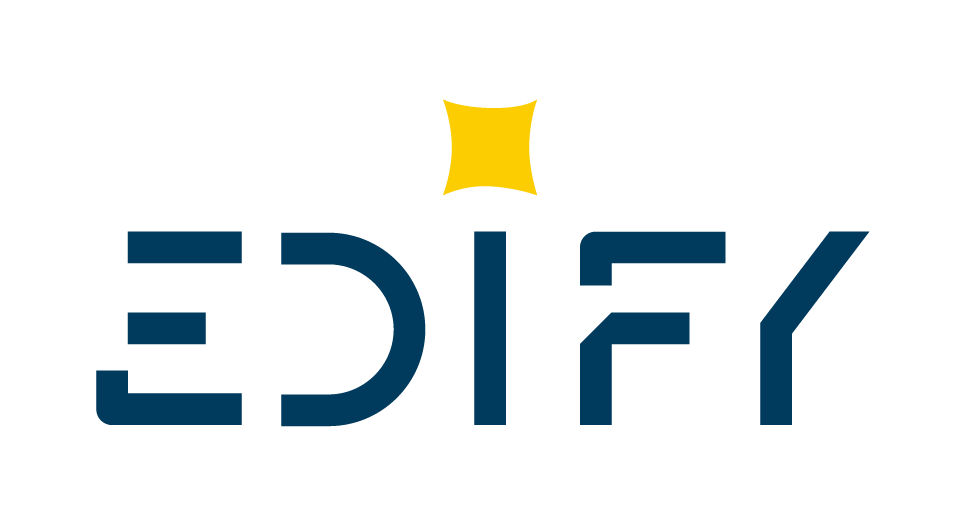
Photonic is all around us: from communications and health, to materials processing in production, ligting and photovoltaics, and everyday products like DVD players and mobile phones. Yet the full disruptive potential of photonics is only now becoming clear. New advances in this sector are expected to revolutionise multiple sectors form healthcare, manufacturing, electronics, communications technologies, to energy efficiency and sensor applications applied across all environments form specialized professional environment to consumer markets.
WORK PACKAGES EDIFY
The EDIFY work plan consists of 7 Work Packages, starting with the Project Management WP1, the four research WPs (WP2–WP5), one WP on Training (WP6), and finally one on Communication, Dissemination and Exploitation (WP6).
The four research packages and their connection with the ESRs are described as follows:

Development of compact models for integrated photonics´ InP fabrication
This WP will focus on the generation of compact models for large-scale fabrication in InP foundries. It will start with a complete and detailed plan and workflow for measurement and control manufacturing tasks in an integrated photonics foundry. Followed by the development of a dedicated design that will be used as a process control module. An automatized system for control and measurement activities in the manufacturing chain will be developed. This system will also provide feedback to refine the proposed model. Participating ESRs will work with scientific participants to apply statistical models to study the performance of the fabricated building blocks and the development of software simulation tools to define the automation process.

Development of low loss waveguides
This WP will focus on the generation of low-loss waveguides for InP integrated photonics ASPICs. After elaborating a complete test plan, in a study of the impact of diffusion of Zn on the active building blocks will be accomplished. This will be achieved by simulation followed by fabrication process development, including performance and monitoring. It will be followed by measurements of the final performance of the devices fabricated. Several fabrication runs are planned to calibrate the process and to optimize the performance of booth active (lasers, amplifier, modulators) and passive (splitters, filters, interferometers) the building blocks. Participating ESRs will work with scientific participants to apply theoretical models, develop new tools, new building blocks and software simulations for this new generation of waveguides with small losses. They will provide valuable data to obtain compact models (WP2) for the generation of the new PDK associated to this fabrication process.

Development of Aluminium containing quantum Wells
This WP will focus on the generation of Aluminium containing quantum wells for active devices in InP integrated photonics ASPICs. After elaborating a complete test plan, there will be a characterization of the interfaces between InGaAsP and AlInGaAs materials, followed by a careful study of the oxidation/passivation of the quantum wells and a complete survey of the results and performance of the building blocks. Participating ESRs will work with scientific participants to apply theoretical models, develop new building blocks, test structures and software simulations for this new generation of devices with Al containing quantum wells. They will provide valuable data to obtain compact models (WP2) and compare the results and modelling obtained with the phosphorus containing quantum wells that were generated from WP2.

Development of application oriented PICs
The goal of the WP is to demonstrate improved performance of more advanced PICs in which the technologies developed in WP3 and 4 are used. To develop new, more complex ready to use application-oriented PICs, the compact models developed in WP1 and the technology maturity of WP3 and WP4 will be validated. This next generation PICs will include sensing oriented circuits such as: low linewidth laser, widely tuneable laser, low repetition mode-locked laser; telecom oriented: advanced transmitters which contains Al QWs laser and modulators: datacom oriented: transmitter operating in O-
DELIVERABLES
Scientific Course SC1
Through the Doc‐TIC PhD Programme a number of course modules in areas related to photonics (active and passive devices), quantum mechanics, solid‐state physics and integrated photonics are given to the ESRs. This first of group of Scientific‐based courses (SC1) offered to each ESR is already tailored to refresh previous concepts and as an introduction to modern physics concepts and photonics.
Keywords: Photonics, Physics, Solid‐state physics, Robotics, Training, Automation
Scientific Course Sc2
Through the Doc‐TIC PhD Programme a number of course modules in areas related to photonics (active and passive devices), quantum mechanics, solid‐state physics and integrated photonics are given to the ESRs. This first of group of Scientific‐based courses (SC1) offered to each ESR is already tailored to refresh previous concepts and as an introduction to the basic concepts of photonic integration; to understand the physics and behaviour of semiconductor optoelectronic devices
Keywords: Photonics, Physics, Solid‐state physics, Robotics, Training, Automation
Scientific Course SC4
Through the Doc‐TIC PhD Programme a number of course modules in areas related to photonics (active and passive devices), quantum mechanics, solid‐state physics and integrated photonics are given to the ESRs. This Scientific‐based course (SC4) offered to each ESR is a hands on session on Photonic Design Automation for core and metro WDM systems, optical access networks, lasers as well as active devices and circuits.
Keywords: Photonic design automation, simulation, Physics, Solid‐state physics, Training
EDIFY Vacancies Published
Through Euraxess and other web sites, advertisements for EDIFY Jobs were posted.
Keywords: Integrated Photonics, research, job offer, employment, ESR
Overall Recruitment
In this deliverable we report on the recruitment process and the recruitment results within the EDIFY project. We also comment on the application timeline and on the selection process. In summary, after approximately one year all ESR positions could be filled with very promising candidates. The deviation of the original work plan due to delays in the recruitment of up to 2 months for one ESR will not impede with the further course of the project, since the periods of secondments are flexible and training activities are adapted to the delays.
Keywords: Recruitment, work plan, elegibility, research, job offer, employment, ESR
Website (First version)
A website has been developed and social media accounts have been envisaged for the EDIFY project. The visual identity of EDIFY and the website structure have been developed as part of the corporate branding deliverable.
Keywords: Website, Open Access, Media, Events, Training, Events







